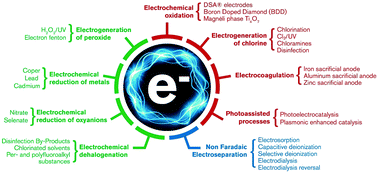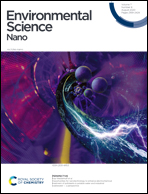Opportunities for nanotechnology to enhance electrochemical treatment of pollutants in potable water and industrial wastewater – a perspective†
Abstract
Based upon an international workshop, this perspective evaluates how nano-scale pore structures and unique properties that emerge at nano- and sub-nano-size domains could improve the energy efficiency and selectivity of electroseparation or electrocatalytic processes for treating potable or waste waters. An Eisenhower matrix prioritizes the urgency or impact of addressing potential barriers or opportunities. There has been little optimization of electrochemical reactors to increase mass transport rates of pollutants to, from, and within electrode surfaces, which become important as nano-porous structures are engineered into electrodes. A “trap-and-zap” strategy is discussed wherein nanostructures (pores, sieves, and crystal facets) are employed to allow localized concentration of target pollutants relative to background solutes (i.e., localized pollutant trapping). The trapping is followed by localized production of tailored reactive oxygen species to selectively degrade the target pollutant (i.e., localized zapping). Frequently overlooked in much of the electrode-material development literature, nano-scale structures touted to be highly “reactive” towards target pollutants may also be the most susceptible to material degradation (i.e., aging) or fouling by mineral scales that form due to localized pH changes. A need exists to study localized pH and electric-field related aging or fouling mechanisms and strategies to limit or reverse adverse outcomes from aging or fouling. This perspective provides examples of the trends and identifies promising directions to advance nano-materials and engineering principles to exploit the growing need for near chemical-free, advanced oxidation/reduction or separation processes enabled through electrochemistry.

- This article is part of the themed collections: SDG6: Clean water & sanitation and Environmental Science: Nano Cover Art


 Please wait while we load your content...
Please wait while we load your content...
